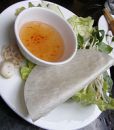Spa Cuisine Of Vietnam
 Vietnamese cuisine, like others in Indo-China, has been deeply influenced by the Chinese, the Indians, and to a significant extent the French. Like the Chinese, the Vietnamese use chopsticks and eat from bowls rather than plates. They stir-fry their food and regard rice and noodles as their staples. Within Vietnam itself, North Vietnamese cuisine bears the most resemblance to Chinese cuisine. This could be due to the area’s proximity to the Chinese border. Soya sauce is preferred over fish sauce, and black peppers rather than chillies are used to spice up a dish. In contrast, South Vietnamese cuisine features nuoc mam (fish sauce), chillies, coconut and spices, ingredients more commonly found in Thai or Indian cuisine. Nuoc mam accompanies practically every dish just as nam pla (as fish sauce is known as in Thailand) accompanies most Thai dishes. As to the French, their presence in Vietnam from the 16th to the mid-20th centuries saw them introducing their philosophy of food and eating to the Vietnamese. Ingredients such as asparagus and avocados, and techniques of cooking such as sauteing, were introduced into Vietnamese cuisine. For instance, a Vietnamese sandwich can be made from a baguette and pate. Today, the distinct flavours we associate with Vietnamese cuisine come primarily from mint leaves, coriander, lemon grass, shrimp, nuoc mam, ginger and other herbs. A typical Vietnamese meal comprises rice or noodles, fresh vegetables and herbs. Vietnamese dishes are also usually cooked in water rather than oil. Desserts are not common, though sweets and cakes are offered to guests at the end of a meal.
Vietnamese cuisine, like others in Indo-China, has been deeply influenced by the Chinese, the Indians, and to a significant extent the French. Like the Chinese, the Vietnamese use chopsticks and eat from bowls rather than plates. They stir-fry their food and regard rice and noodles as their staples. Within Vietnam itself, North Vietnamese cuisine bears the most resemblance to Chinese cuisine. This could be due to the area’s proximity to the Chinese border. Soya sauce is preferred over fish sauce, and black peppers rather than chillies are used to spice up a dish. In contrast, South Vietnamese cuisine features nuoc mam (fish sauce), chillies, coconut and spices, ingredients more commonly found in Thai or Indian cuisine. Nuoc mam accompanies practically every dish just as nam pla (as fish sauce is known as in Thailand) accompanies most Thai dishes. As to the French, their presence in Vietnam from the 16th to the mid-20th centuries saw them introducing their philosophy of food and eating to the Vietnamese. Ingredients such as asparagus and avocados, and techniques of cooking such as sauteing, were introduced into Vietnamese cuisine. For instance, a Vietnamese sandwich can be made from a baguette and pate. Today, the distinct flavours we associate with Vietnamese cuisine come primarily from mint leaves, coriander, lemon grass, shrimp, nuoc mam, ginger and other herbs. A typical Vietnamese meal comprises rice or noodles, fresh vegetables and herbs. Vietnamese dishes are also usually cooked in water rather than oil. Desserts are not common, though sweets and cakes are offered to guests at the end of a meal.